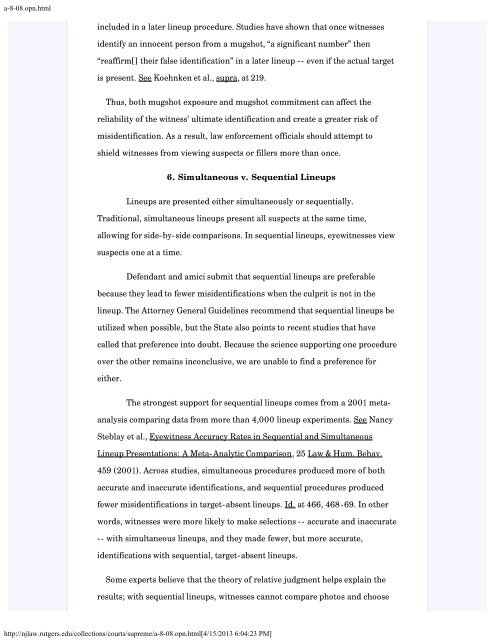State v. Henderson and the New Model Jury Charges - New Jersey ...
State v. Henderson and the New Model Jury Charges - New Jersey ...
State v. Henderson and the New Model Jury Charges - New Jersey ...
Create successful ePaper yourself
Turn your PDF publications into a flip-book with our unique Google optimized e-Paper software.
a-8-08.opn.html<br />
included in a later lineup procedure. Studies have shown that once witnesses<br />
identify an innocent person from a mugshot, “a significant number” <strong>the</strong>n<br />
“reaffirm[] <strong>the</strong>ir false identification” in a later lineup -- even if <strong>the</strong> actual target<br />
is present. See Koehnken et al., supra, at 219.<br />
Thus, both mugshot exposure <strong>and</strong> mugshot commitment can affect <strong>the</strong><br />
reliability of <strong>the</strong> witness’ ultimate identification <strong>and</strong> create a greater risk of<br />
misidentification. As a result, law enforcement officials should attempt to<br />
shield witnesses from viewing suspects or fillers more than once.<br />
6. Simultaneous v. Sequential Lineups<br />
Lineups are presented ei<strong>the</strong>r simultaneously or sequentially.<br />
Traditional, simultaneous lineups present all suspects at <strong>the</strong> same time,<br />
allowing for side-by-side comparisons. In sequential lineups, eyewitnesses view<br />
suspects one at a time.<br />
Defendant <strong>and</strong> amici submit that sequential lineups are preferable<br />
because <strong>the</strong>y lead to fewer misidentifications when <strong>the</strong> culprit is not in <strong>the</strong><br />
lineup. The Attorney General Guidelines recommend that sequential lineups be<br />
utilized when possible, but <strong>the</strong> <strong>State</strong> also points to recent studies that have<br />
called that preference into doubt. Because <strong>the</strong> science supporting one procedure<br />
over <strong>the</strong> o<strong>the</strong>r remains inconclusive, we are unable to find a preference for<br />
ei<strong>the</strong>r.<br />
The strongest support for sequential lineups comes from a 2001 metaanalysis<br />
comparing data from more than 4,000 lineup experiments. See Nancy<br />
Steblay et al., Eyewitness Accuracy Rates in Sequential <strong>and</strong> Simultaneous<br />
Lineup Presentations: A Meta-Analytic Comparison, 25 Law & Hum. Behav.<br />
459 (2001). Across studies, simultaneous procedures produced more of both<br />
accurate <strong>and</strong> inaccurate identifications, <strong>and</strong> sequential procedures produced<br />
fewer misidentifications in target-absent lineups. Id. at 466, 468-69. In o<strong>the</strong>r<br />
words, witnesses were more likely to make selections -- accurate <strong>and</strong> inaccurate<br />
-- with simultaneous lineups, <strong>and</strong> <strong>the</strong>y made fewer, but more accurate,<br />
identifications with sequential, target-absent lineups.<br />
Some experts believe that <strong>the</strong> <strong>the</strong>ory of relative judgment helps explain <strong>the</strong><br />
results; with sequential lineups, witnesses cannot compare photos <strong>and</strong> choose<br />
http://njlaw.rutgers.edu/collections/courts/supreme/a-8-08.opn.html[4/15/2013 6:04:23 PM]
















